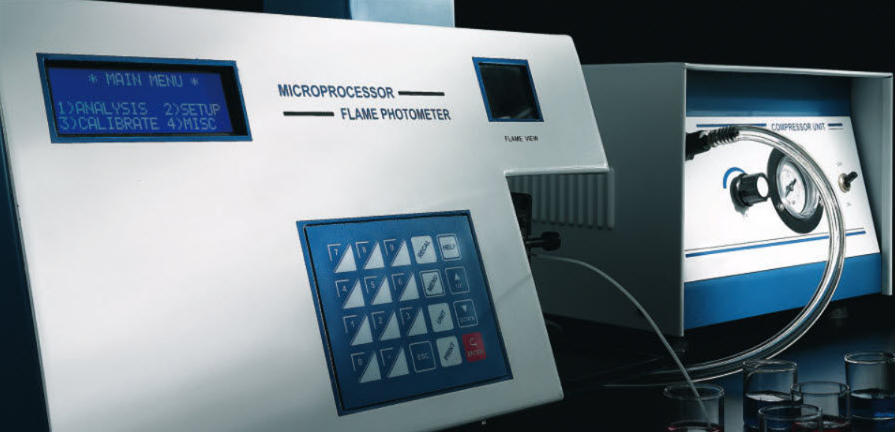Flame photometer
Mastering the Optimal Use of Flame Photometers
In many laboratories, it is common to encounter issues such as fluctuating measurement results across runs, non-linear calibration curves, or signal decline after prolonged use. These problems rarely stem from a single cause; rather, they arise from a combination of factors including sample preparation, operating conditions, calibration, and maintenance. This article compiles practical experience to help you establish a stable, repeatable workflow that also meets laboratory data management requirements.
What is a Flame Photometer?
A flame photometer is an instrument used for the rapid quantification of certain alkali and alkaline earth metals in solution—such as sodium, potassium, calcium, and lithium—based on atomic emission. When the sample is introduced into a flame, the elements emit radiation at characteristic wavelengths. The device records the intensity and converts it into concentration. Thanks to its simplicity, fast response time, and cost-effective operation, the flame photometer is widely used in agriculture, biomedical research, environmental testing, food analysis, and industrial production.

Proper Sample and Standard Preparation
A frequently asked question is whether it is mandatory to use deionized water. The answer is yes, because regular water may contain background ions that interfere with the signal. Both samples and standard solutions should be prepared with deionized water, clean glassware, and clearly defined weighing and dilution procedures. The concentration range of the standard solutions should cover and approximate the expected sample concentrations so that the calibration curve remains meaningful for interpolation. Recording details such as preparation conditions, reagent batches, and preparation time helps with traceability if deviations occur.
Many users wonder why the instrument runs smoothly at the beginning but becomes unstable during continuous operation. The most common causes are fluctuations in gas supply and environmental conditions. Gas pressure must be maintained in accordance with the manufacturer’s recommendations to sustain a stable flame. The laboratory should avoid direct drafts and control temperature and humidity within the specified range. Placing the instrument in a dry, well-ventilated location minimizes signal drift and extends component lifespan.
Calibration Before Each Session and Linearity Checks
Another common question is whether calibration is necessary before every measurement session. The recommendation is to perform calibration at the start of each session, or whenever a new batch of samples with different matrices is introduced. A typical procedure includes setting the zero point with deionized water, followed by measuring standard solutions in increasing concentrations to construct the calibration curve. Evaluating correlation coefficients, slope values, and running quality control (QC) samples helps detect abnormalities early. If repeatability is poor or the calibration curve deviates significantly from historical data, measurements should be halted and the instrument, gas supply, and sample aspiration system should be inspected.
When analyzing real samples, readings should be recorded only after the signal stabilizes as recommended for the specific model. Results are then interpolated from the calibration curve or adjusted using established factors. For samples with complex matrices, appropriate dilution and recovery checks are essential to evaluate matrix effects. Data should be automatically logged via software to minimize manual transcription errors and meet quality management requirements.
Cleaning and Maintenance for Consistency
Another frequent question is whether the instrument needs to be cleaned after each use. In practice, salt residues or suspended particles can easily accumulate on the nebulizer, aspiration tube, and burner, directly affecting the signal. Rinsing with deionized water after each session is essential. For instruments in frequent use, a regular inspection schedule for consumable parts should be established, and preventive maintenance should follow the manufacturer’s guidelines to sustain measurement performance and minimize downtime.
Sampling Tools and Handling Practices
Some users consider switching from glass to plastic containers for convenience. While plastic can be used, clean glassware usually provides better stability because it retains fewer impurities. Regardless of the choice, thorough washing, rinsing with deionized water, and proper drying remain prerequisites. For high-throughput testing, it is advisable to follow recommended operating and rest intervals to ensure both instrument durability and result reproducibility.
Common Issues and Quick Troubleshooting
Measurement fluctuations between runs are often linked to variable gas pressure, deposits on the nebulizer, or differences between sample matrices and the standard solutions. A quick diagnostic sequence should begin by checking the gas pressure, re-measuring the zero point with deionized water, and re-running the calibration standards to verify curve stability. If the signal remains unstable after these steps, cleaning the sample aspiration system is necessary. Should the issue persist, recalibration or technical service may be required.
-
-
-
-
-
-
-
-
-
-
-
-
-
-
-
-
-
-
-
-
-
-
-
-